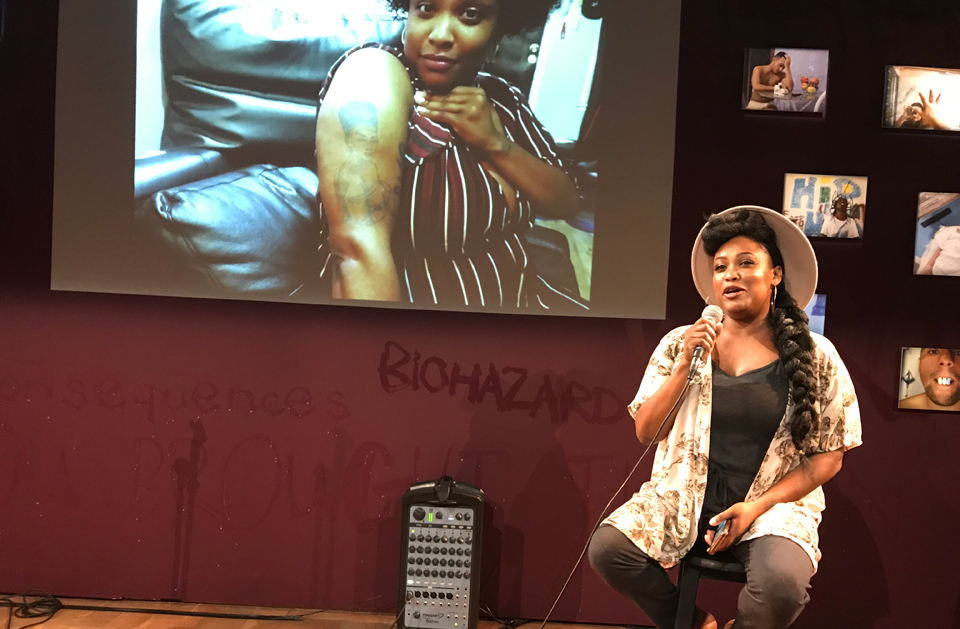
LOS ANGELES—A broadly conceived, eye-opening exhibition on the human condition awaits the visitor at UCLA’s Fowler Museum on the expansive West L.A. campus. The range of images included recalls the famous book The Family of Man, based on a 1955 exhibition at New York’s Museum of Modern Art organized by photographer Edward Steichen.
The distinguishing feature of Through Positive Eyes, which featured an opening night cultural program with music, video, and speakers on October 5, is that all of the subjects—more than 130 people found by artist-activists from ten cities across the globe—are living with HIV/AIDS.
This large-scale video, photography and storytelling project was created in collaboration with a collective of courageous “artivists” in Los Angeles, who gave personal witness at the opening event. The exhibition also includes an installation by L.A.-based multimedia artist Allison Saar.
Together, these works conjure a broad picture of the worldwide epidemic, ranging from everyday imagery to more abstract meditations on joy, grief, solitude, community, and resilience.
These artistic statements, coming from a variety of perspectives in terms of gender, sexuality, age, class, ethnicity, and nationality, are united under a common theme: To wield artistic expression as a powerful tool for combating stigma.
Stigma and all it entails—shame, isolation, embarrassment, exclusion, shunning—remains among the most formidable barriers to fighting the epidemic. It starts early on, with religious and cultural resistance to speaking honestly, and age-appropriately, about sex. And not only about sex but drugs, needles, medicine, epidemiology, and science. Some of the people with HIV, both in the photos and in the local collective, were born with the infection. Others acquired it through a transfusion, an infected needle stick, or unprotected sexual activity.
If someone is concerned that they might have been exposed to HIV, in many cultures they may feel inhibited from getting themselves tested and treated. An HIV diagnosis could lead to immediate loss of family, community, and friends—and to excommunication, demoralization, depression, and despair. It may lead to a lifetime spent fighting inadequate medical care systems and organizing for healthcare justice.
Stigma is tied to ignorance, discrimination, religion, and judgment. The world should never forget that it was Indiana Governor Mike Pence who disallowed needle exchange, an important medical safety protocol for intravenous drug users. So in that state’s rural Scott County, home to fewer than 24,000 people, a whopping 215 cases of HIV suddenly surfaced in 2014.
Now that the right-wing Christian evangelical Pence is in the White House as Trump’s vice president, the administration is doubling down on denial of healthcare to more and more Americans and using U.S. foreign aid to prevent informed consultation about abortion and other reproductive rights abroad. It is trying to eliminate Medicare and Medicaid and shut down Planned Parenthood (which does HIV testing for its clients). Under the provisions of its ill-conceived “religious freedom” policy, the Trump/evangelical regime would allow medical providers (pharmacists, doctors, nurses) to deny care to anyone who offends their personal moral codes. That could mean any LGBTQ people, single women enjoying a sex life, divorced persons, people of another religion or with distinct dress, etc. The gate will be thrown open not only to discrimination but to disastrous healthcare outcomes. Already we see that over the past two or three years, the average life expectancy in the U.S. has fallen dramatically.
This is what we’re talking about when we talk about stigma. Multiply the U.S. experience by any number of religions and countries with prejudiced, unscientific approaches toward the diversity of the human family.
Illuminating and fresh as it is, Through Positive Eyes holds back on many of these larger societal and political concerns, concentrating its focus on the individual and personal—curiously, the same criticism some viewers had of The Family of Man in the 1950s. By falling short addressing the epidemic on that level, we don’t come away with a clear notion of the way different social systems treat it, and why some models are more effective than others. Viewers are left to ask their own questions and draw their own conclusions.
The epidemic has engendered a wide range of creative responses since the disease was first recognized in 1981. Through Positive Eyes is the Fowler’s sixth exhibition since 2002 dedicated to the intersection of art and HIV/AIDS, including the pathbreaking 2008 exhibitions Make Art/Stop AIDS and Dress Up Against AIDS: Condom Couture by Adriana Bertini. The UCLA museum has been taking seriously its commitment to artists helping to overcome fear and banish stigma. The current exhibition educates and celebrates individual and collective cultural practices, especially art in the service of activism.
David Gere is director of UCLA’s Art and Global Health Center and professor of World Arts and Cultures. He has been involved in 12 years of Through Positive Eyes workshops around the world, helping to amass this compelling body of portraits and videos of people living with HIV/AIDS around the world. At the Oct. 6 opening event, he thanked sponsors of the project and introduced the local artivists involved with the project.
Kelly Gluckman spoke of her HIV diagnosis at the age of 23. “I lost my youth and my youthful state of mind,” she recalled. Now 32, she is for the first time in a healthy relationship, but as she ages, she finds herself “more concerned about cellulite than my t-cells.”
Lynnea Garbutt was born with HIV to a mother with HIV, and never dreamed she would become a mother herself. She became a godmother to her best friend’s children. Later, owing to medical advances, not only is she thriving herself, but she became pregnant and gave birth to an HIV-negative baby. That beautiful, feisty little girl, Nae’Lyn, joined Lynnea on stage to rapturous applause from the audience.
Joey Terrill, a middle-aged Chicano from L.A., encountered AIDS early on in the epidemic as friends and lovers came down with it. He soon discovered that aside from scorn and discrimination from the larger world—it was the age of President Ronald Reagan, who infamously did not even publicly utter the word “AIDS” for the first seven years of his presidency—“disgrace would also come from within our own community of friends.” Along with the usual divisions of ethnicity and class, now we started putting people in boxes labeled “positive” and “negative.”
Terrill has traveled to South Africa, one of the most highly HIV-infected countries in the world, where he has worked with the Ntethelelo Foundation to support young girls in the Alexandria slum of Johannesburg, helping them gain self-respect and skills in a township of much abuse and poverty. That project is supported by L.A.’s AIDS Healthcare Foundation. The AIDS crisis has affected virtually every family of those girls, some of whom are HIV+ themselves.
Versions of the Through Positive Eyes exhibition have been shown in South Africa, as well as in other nations.
Vasilios Papapitsios (Vas) believes that “the easiest way to overcome fear is to breathe.” He grew up in the Greek Orthodox community in North Carolina, where there was no education about sex or HIV/AIDS. He reported going to a party where he was drugged and raped, acquiring HIV at age 19. In severe denial, shame and ignorance, he refused treatment for five years, until he weighed 104 pounds, got very sick, and was given one to three months to live. At that point, he resolved to “step out of fear into love” and in the first three months gained 30 pounds and got his t-cells back into normal range. “Disclosure is one of the most important parts of fighting HIV,” he says.
Porchia Dees admits it: “I’m a beautiful Black queen living with HIV.” Born positive in 1986, she attended camps and summer programs with other children with serious medical challenges and watched as many of them died. She realized that with her treatable HIV, other people had it much worse. She has experienced shaming, but has learned that “Rejection is a reflection of other people’s projection.” In love with life, she knows in her heart that HIV has turned out to be “God’s gift, a blessing in disguise.”
The final presenter at the opening night performance was Thomas Davis, a lithe young African-American dancer. Thomas felt numb for weeks after his initial HIV diagnosis, but decided to concentrate with ever greater commitment on his chosen career. “Dance allowed me to process so many things I was unable to put into words.”

These HIV-positive artivists will continue to share their images and personal narratives in direct dialogue with museum goers through live storytelling in the “Banishing Stigma Room,” the final gallery space of the exhibition. They will appear on Wednesdays from 5 to 7:30 pm on Oct. 16, 23 and 30, Nov. 6, 13 and 20, Dec. 4, 11 and 18, Jan. 8, 15, 22 and 29, and Feb. 5 and 12. Also on Sundays from 12:30 to 3:30 pm on Oct. 13, 20 and 27, Nov. 3, 10, 17 and 24, Dec. 1, 8, 15, 22 and 29, Jan. 5, 12, 19 and 26, and Feb. 2, 9 and 16.
In conjunction with World AIDS Day, the Fowler hosts a book signing with Prof. David Gere to celebrate the release of the exhibition publication Through Positive Eyes. The signing will follow the 1 pm screening of the 110-minute 2012 film How to Survive a Plague about militant HIV/AIDS activism in the 1980s.
Two other films are slated in connection with the exhibition. On 7 p.m. on Weds., Oct. 23, the Fowler will screen the 67-minute 2017 film Nothing Without Us: The Women Who Will End AIDS, which looks at the unaddressed dynamics that keep women around the world at risk for HIV, while introducing the remarkable women who have answers to fight the epidemic.
And at 7 p.m. on Weds., Nov. 13, the museum will screen the 74-minute 2018 film Lovesick, about Dr. Suniti Solomon’s medical career fighting AIDS in India, and some of her most unconventional patients. Eight years in the making, Lovesick is a surprising portrait of modern love in the age of AIDS.
Through Positive Eyes closes Feb. 16, 2020. For further information, call (310) 825-4361 or go to www.fowler.ucla.edu. The Fowler Museum is located at 308 Charles E. Young Dr. North, Los Angeles 90024. Hours are Weds., 12- 8 p.m., and Thurs.-Sun., 12-5 p.m. There is no admission charge to the Fowler Museum.
Like free stuff? So do we. Here at People’s World, we believe strongly in the mission of keeping the labor and democratic movements informed so they are prepared for the struggle. But we need your help. While our content is free for readers (something we are proud of) it takes money — a lot of it — to produce and cover the stories you see in our pages. Only you, our readers and supporters, can keep us going. Only you can make sure we keep the news that matters free of paywalls and advertisements. If you enjoy reading People’s World and the stories we bring you, support our work by becoming a $5 monthly sustainer today.

MOST POPULAR TODAY

After months of denial, U.S. admits to running Ukraine biolabs

“Trail of Tears Walk” commemorates Native Americans’ forced removal

‘Warning! This product supports genocide’: Michigan group aims to educate consumers

Ohio: Franklin County treasurer attends Netanyahu meeting, steps up Israel Bond purchases

Hold the communism, please: SFMOMA’s Diego Rivera exhibit downplays artist’s radical politics






Comments